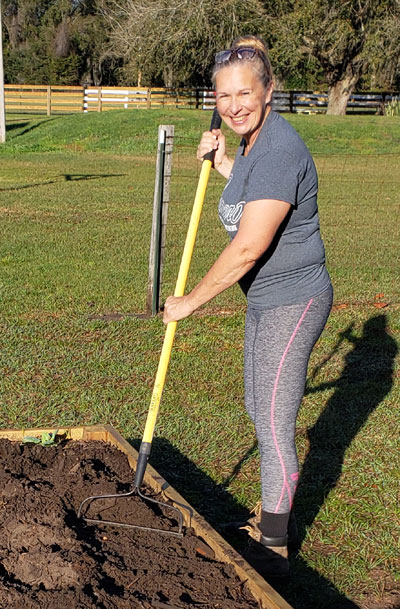The calendar may show the season as winter, in February, but here in Central Florida, we had a busy spring season planting the garden and harvesting our winter crops. Our February garden journal was packed full this month.
Click the links below for shortcuts to each section.
- Week 1
- Week 2
- Week 3
- Week 4
- What’s Blossoming Now
- Harvest Summary
- Resources
- What’s Next?
- What do You Think?
Journal Entries Week 1
February was peak harvest season for our loquat tree in the back yard. The first day of the month I picked 26 fruits – just enough for snacking at work that week. There were plenty more unripe fruits and blossoms promising even bigger harvests to come.
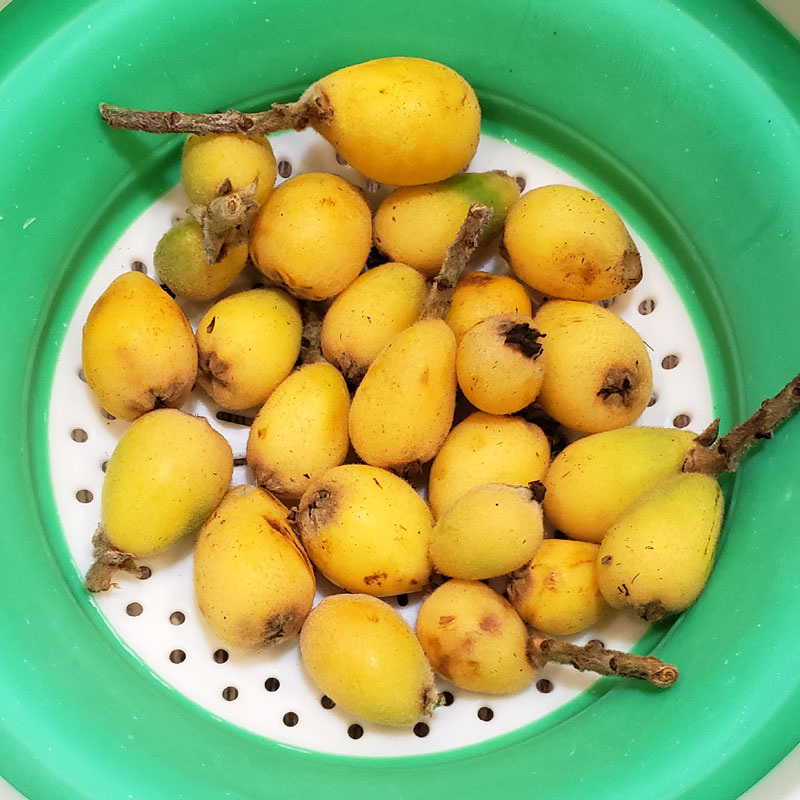
The tomato seedlings under the grow lights were growing fast so I needed to get them potted up soon. I went out to the garden shed and gathered my pots, brought them inside and washed them out with warm water and some white vinegar, making sure to rinse the pots thoroughly before adding the potting soil. Once again, I reminded myself that I should wash the pots before storing and avoid this last-minute rush. With so much going on in the garden, will I even remember to do that? Ha!
February 4th was our big potato planting day!
I planned out spacing for the potatoes into three raised beds and twelve 5-gallon buckets.
We amended the soil in the beds with Black Kow brand composted manure. Our plan is to eventually compost organic cow manure of our own. But until we get that system up and working, we’ll amend with purchased organic products.
I had never planted potatoes in raised beds before, only in-ground. Mike and I watched a few YouTube videos that fellow Floridians had posted of how to plant them. We decided to dig deep trenches about eight inches deep. Each potato was set cut-side down, covered with soil, and watered in. I placed the potatoes about a foot apart which gave me 6-7 potatoes per row. There were three rows per bed.
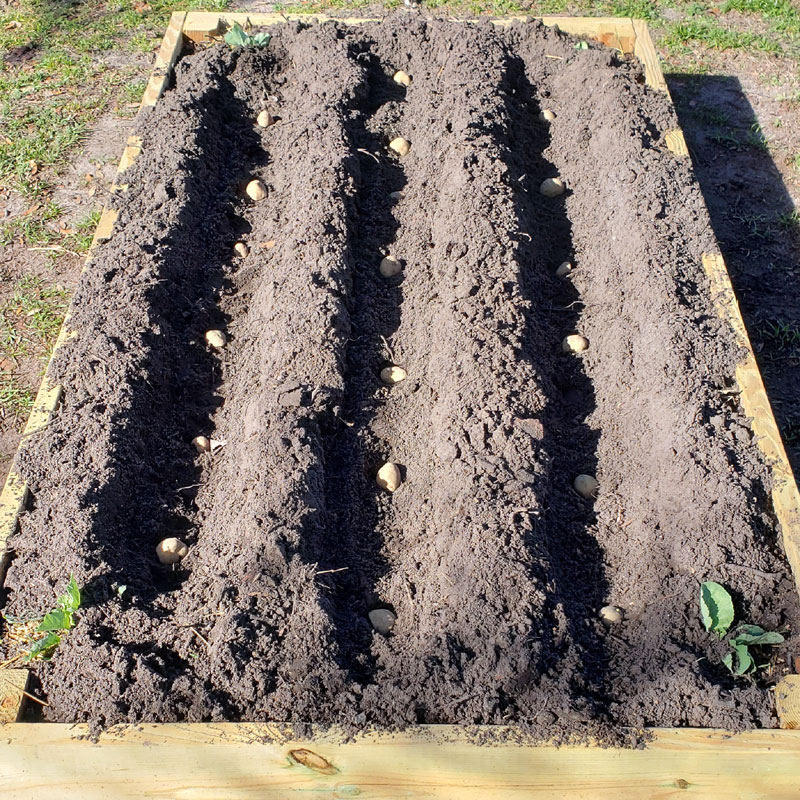
In the buckets, we filled them hallway with soil, placed a potato, then covered with about six inches of soil. All the beds and buckets were covered with a 1-inch layer of mulch to retain moisture. The four varieties of potatoes we planted were: White Kennebec, Yukon Gold, Red Pontiac, and Red Lasota. You can read about how we chitted the potatoes in last month’s Garden Journal Post here.
Later that same day, we brought out the wood chipper and chipped more oak tree and loquat tree trimmings. We burned the small branches, brush, and vines. We mixed the wood ash into our dirt pile that we use to fill the raised beds.
Journal Entries Week 2
By the second week of February, we were in full-blown planting season.
Mike built the four 2’x6’ small raised beds that we would use as a base for the arches in the orchard to grow vining plants.
He also built two more 4’x8’ raised beds. After using the propane torch to clear the weeds and grass, we placed the raised beds and put down cardboard to prevent new weed growth. Next, we added a layer of dead sugar cane leaves that we had trimmed earlier after the winter frost. This would gradually break down and add nutrients to the soil. Finally, we put in topsoil from our pile of dirt and decomposing sod that we had created when we put in the patio.
Our largest project that weekend was planting an in-ground garden area we refer to as our “corn field.”
A neighbor helped us out and used his tractor and implement to till an area we had marked out for a garden. After raking out the larger clumps of sod, we planted six rows of corn with about 30 plants per row. I also planted 3 rows of yellow wax beans with about 35 plants per row.
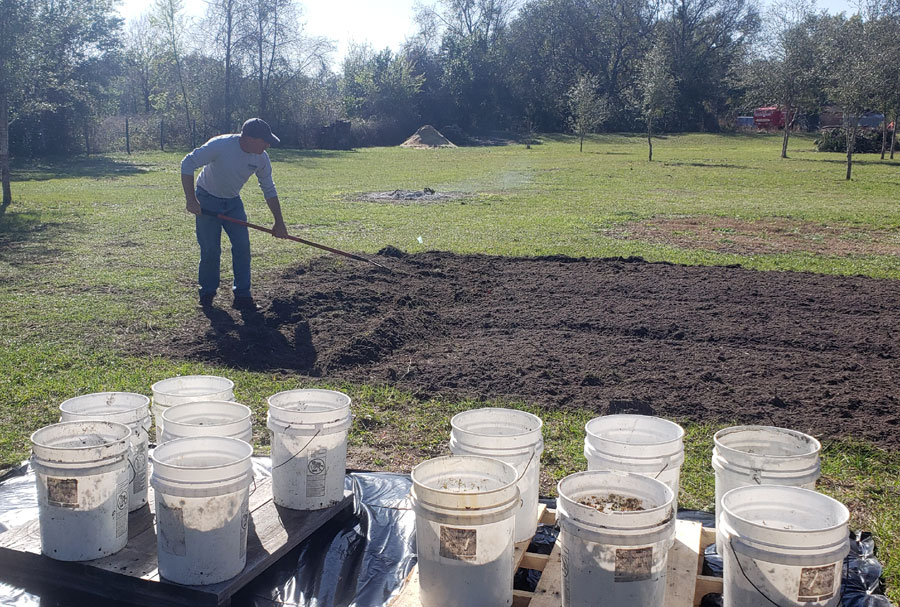
Other things we planted were: 14 cabbage transplants, 3 hills of watermelon (about 8 seeds per hill), and three hills of butternut squash (about 10 seeds per hill).
It was also time to pot up the green bell peppers and habaneros. I used a diluted mix of fish emulsion fertilizer to feed all the potted plants.
Journal Entries Week 3
On the 17th, I spent half a day raking mulch away from fruit trees, adding organic fertilizer, then raking back the mulch. We then added new mulch around some of the trees using Mike’s tractor and our wood we had chipped the past few months.
The dragon fruit trellis was looking bad with several of the dragon fruit vines turning yellow from the winter freeze. I took down about half the plants and composted them. Then I cleaned up the area and added fresh soil for new plants. Thankfully, several of the dragon fruit vines looked like they were thriving. They were the vines I had wrapped with blankets during the frosts and freeze this past winter.
The next day, we went to the local farm store and purchased 3 cattle panels to use as arches for growing vining plants. We assembled two of them in the orchard, and filled the beds at the bases using the same method we used to fill the large garden beds.
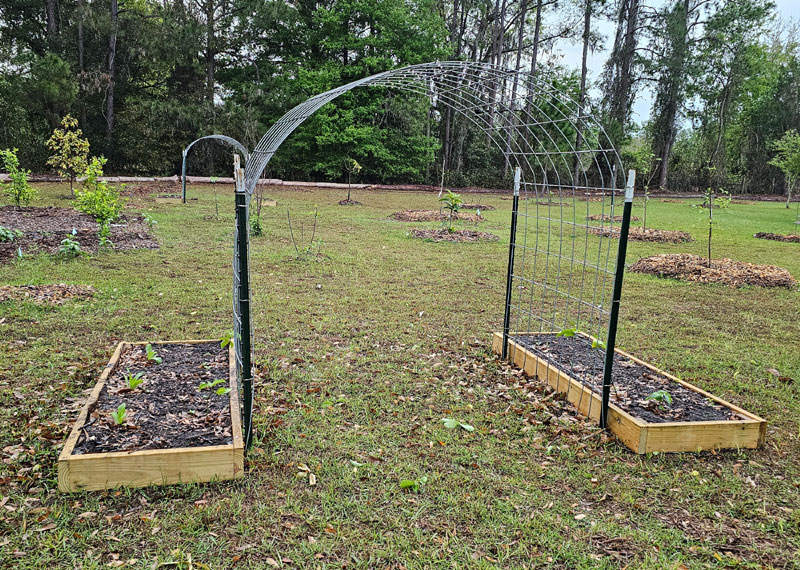
The third cattle panel we installed in between the two trellises we had made for the dragon fruit. We raised them higher with about a foot between the bottom of the panels and the ground. This gave us a beautiful tall arch to walk under. Mike created an ingenious way of attaching the panels to the wood structures using 2 x 4 boards we had on-hand.
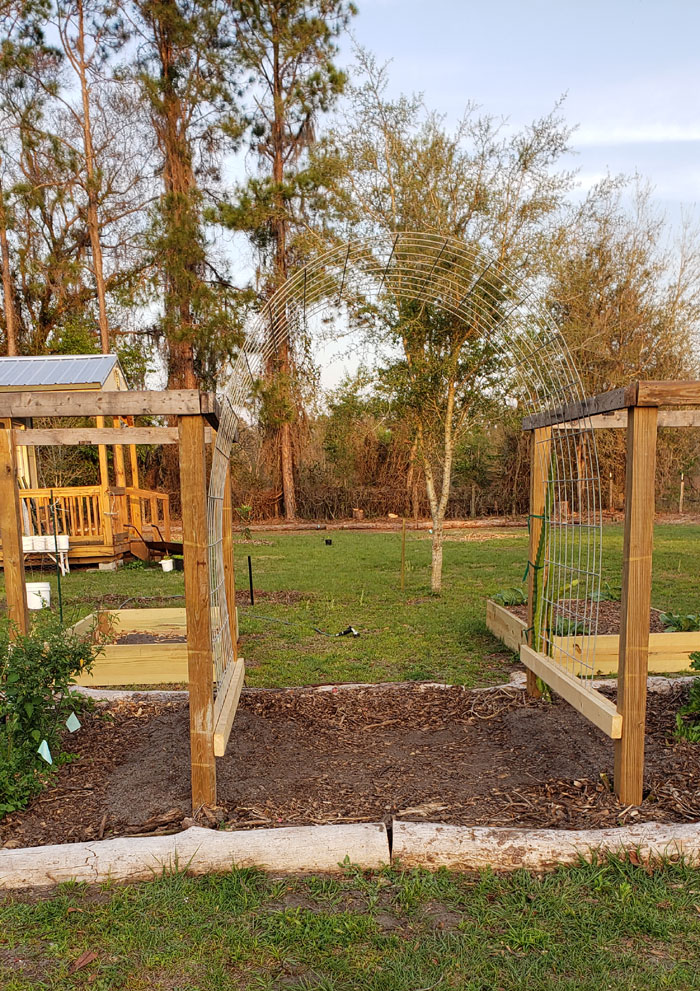
Journal Entries Week 4
Over the last week of February, we planted:
- Passionfruit vines from cuttings
- Luffa that I grew from purchased seeds
- Roselle that I grew from seeds I had saved
- 2 varieties of thornless blackberries we purchased locally
- Yard long beans
- Flowers: marigolds, sunflowers, wildflower mix
The potatoes and corn were beginning to sprout up out of the ground. I began harvesting carrots and beets, and even canned 7 pints of beets this month!
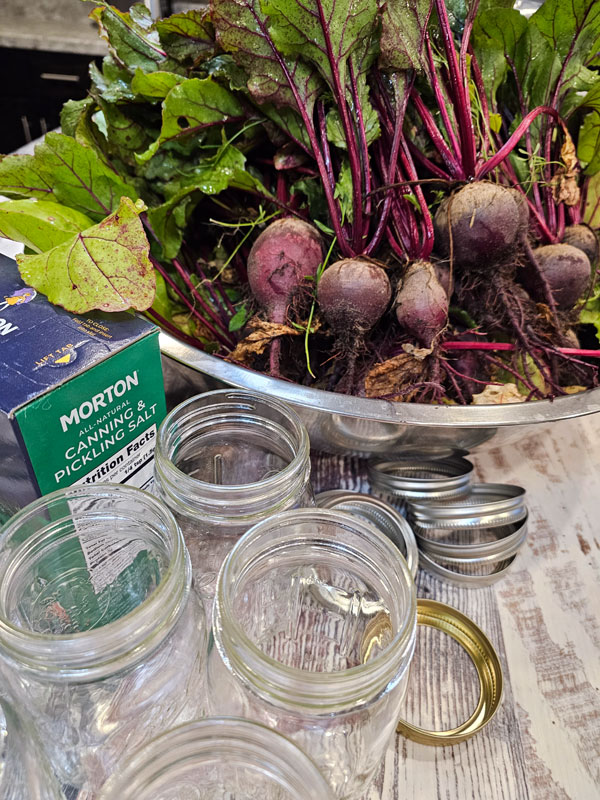
What’s Blossoming Now
- Arugula and mustard going to seed (I’ll be saving seeds for this coming winter)
- Loquat
- Blueberries
- Marigolds and several wildflowers I haven’t identified yet
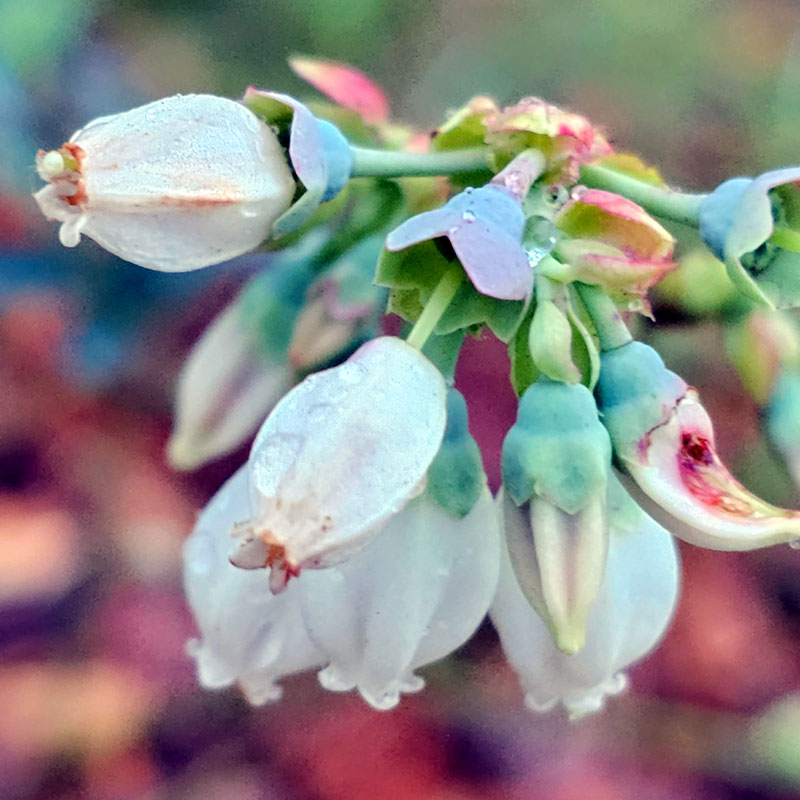
Harvest Summary
- Loquat
- Carrots
- Beets
- Cabbage
Resources
- What is Flame Weeding?
- Read more About Roselle in My Post: Cranberry Hibiscus, Sorrel, or Roselle?
- Planting Potatoes in Raised Beds – YouTube Video
- HomesteadByDesign – Come visit my Etsy Shop and see what’s new!
What’s Next?
Looking ahead to March, we plan to finish planting seeds and starts to fill the raised beds. There are plenty of carrots, beets, and cabbages getting ready to harvest. The peach trees are still dormant. There’s still plenty to do as we transition from a winter garden into a spring/summer garden.
What do You Think?
Seed starting is a very busy garden season, almost as busy as harvest season.
What is your favorite season of a vegetable garden? Planning and designing? Seed starting and planting starts? Watching the garden grow and develop? Harvest? Or maybe clearing out the old debris in anticipation of the next garden?
My favorite season is designing, planning, and sorting through my seed stash. I enjoy planning what foods I will enjoy from the garden, whether fresh-picked, or preserved for later on. Mmmm sauerkraut!
Let me know your favorite in the comments below, thanks!
Until next month, happy gardening!
Alisa
